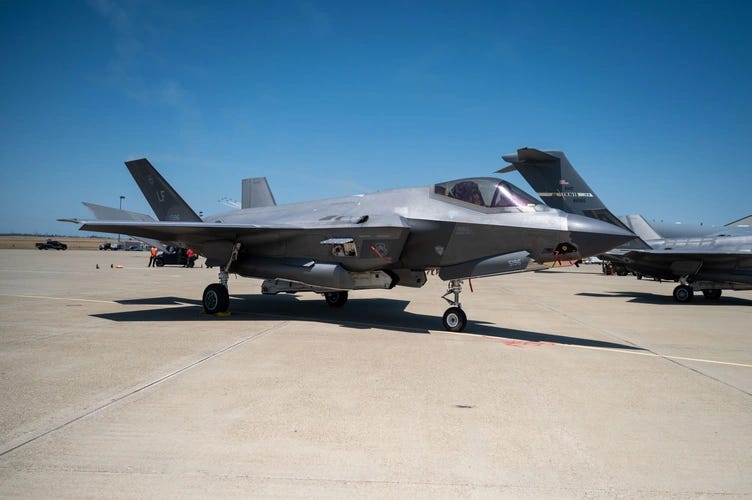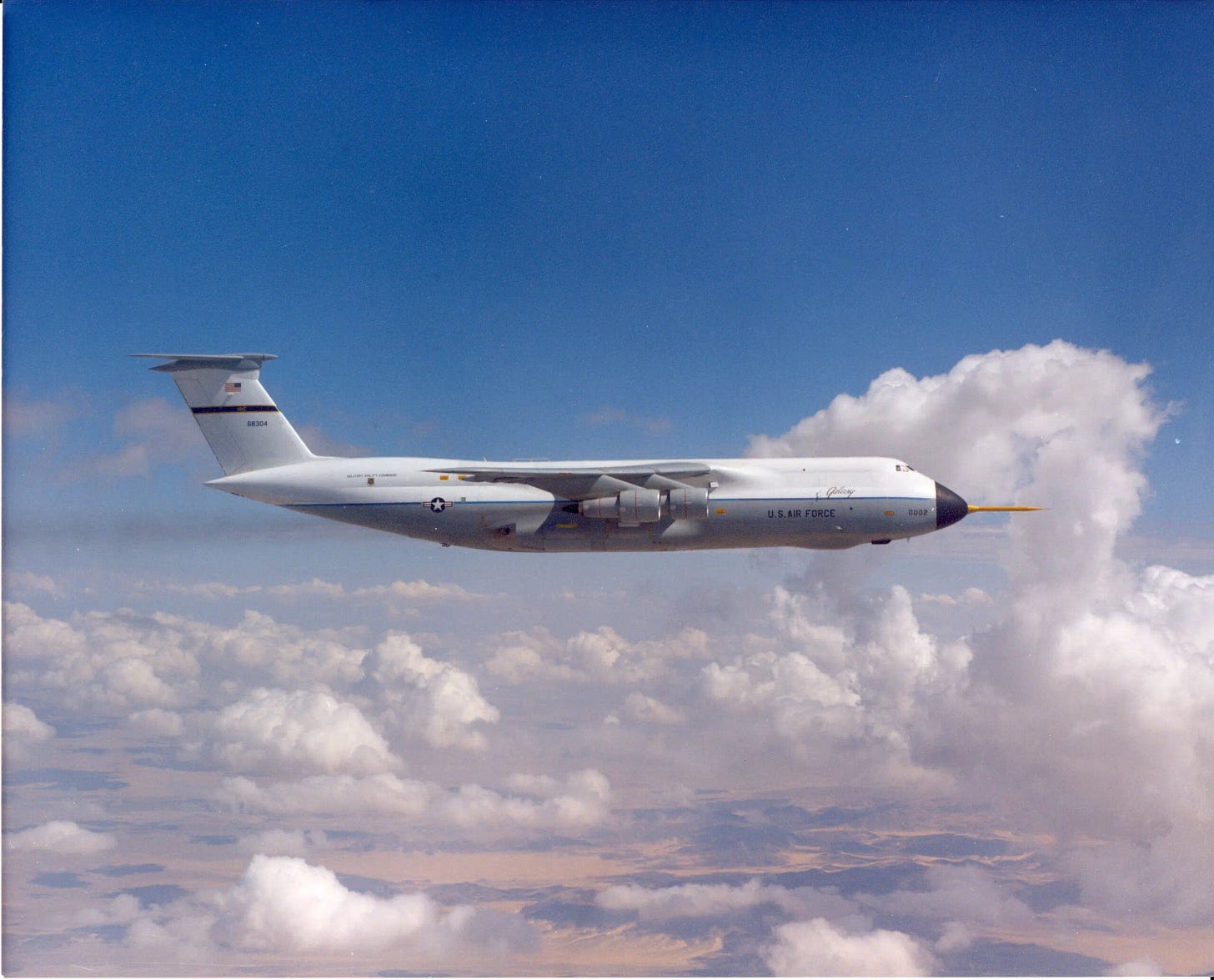Galaxy Tested, Lightning Grounded: A Tale of Two Air Forces
From the C-5A’s record-breaking lift in 1969 to today’s budget-driven cuts to the F-35, the Air Force’s approach to airpower is evolving
"Fighter pilots make movies. Bomber pilots make history."
— General Curtis E. LeMay, U.S. Air Force
Mission Briefing
In a surprising shift, the U.S. Air Force is set to nearly halve its purchase of F-35A Lightning II stealth fighters for Fiscal Year 2026, raising serious concerns about the pace of modernization and the long-term health of the fighter fleet.
According to a draft budget document obtained by Defense News, the Air Force will buy just 24 F-35As next year—down from 44 jets in 2025 and 51 in 2024. The price tag? Nearly $4 billion, representing only an 18% cost reduction despite a 45% drop in quantity. That imbalance highlights a looming problem: reduced economies of scale could drive up per-unit costs, delaying not only procurement but also sustainment and upgrade plans.
A Blow to Modernization
This move comes as the Air Force faces mounting pressure to retire aging fourth-generation fighters like the F-15C/D and F-16C/D, many of which are nearing or have surpassed their design lifespans. Senior Air Force leaders have consistently emphasized that the service must purchase at least 72 new fighters annually to avoid falling further behind. The F-35A—intended to replace these legacy platforms—is central to that plan.
Described as the “quarterback” of the joint force, the F-35A is far more than a replacement aircraft. With stealth characteristics, sensor fusion, advanced electronic warfare systems, and unmatched data-sharing capabilities, it’s designed to act as a force multiplier—gathering, processing, and distributing battlefield information in real time across air, land, and sea domains. It’s not just a fighter—it’s a combat information node.
But the current budget trajectory puts that role in jeopardy.
Behind the Cut: Budget Turbulence and Upgrade Delays
Why the drastic cut? One major factor is the Technology Refresh 3 (TR-3) delay. TR-3 is a crucial hardware and software upgrade that paves the way for the F-35’s Block 4 enhancements—unlocking more powerful computing, expanded sensor capability, improved electronic warfare systems, and integration with next-gen weapons like the AIM-260 Joint Advanced Tactical Missile (JATM). However, persistent delays in TR-3 development and testing have frustrated Air Force leaders, prompting a temporary reduction in orders while the program catches up.
Another issue is the unusual nature of the 2026 budget rollout. The Trump administration has yet to release a complete defense budget proposal for FY26, instead offering fragmented glimpses into its plans. This irregular process has left Congress and Pentagon planners with limited visibility, creating uncertainty in key programs like the F-35.
In contrast, the House Appropriations Subcommittee on Defense is sticking closer to the expected trajectory. Its draft bill provides funding for 42 F-35As for the Air Force, 13 F-35Bs for the Marine Corps (the short takeoff/vertical landing STOVL variant), and additional funds for F-35C carrier-based variants used by both the Navy and Marine Corps.
A Global Fighter with a Growing Mission Set
Despite the setbacks, the F-35 program remains the cornerstone of allied airpower. Operated by over a dozen countries—including the U.S., United Kingdom, Italy, Israel, Japan, Australia, and Norway—the jet has been selected by more than 17 air forces worldwide. As of 2025, over 980 F-35s have been delivered globally, with the fleet logging more than 750,000 flight hours.
The aircraft’s versatility is unmatched. The F-35A is designed for conventional takeoff and landing and is optimized for the U.S. Air Force. The F-35B’s STOVL design enables operations from short airstrips and amphibious assault ships—critical for the Marines. The F-35C variant is built for carrier operations with longer wings, tailhook, and beefed-up landing gear.
And with each software block upgrade, the jet’s capabilities grow. Block 4 is expected to enable integration of more advanced weapons, multi-domain connectivity, and AI-assisted decision support. But those advancements rely on timely funding and full-rate production.
Strategic Risks Ahead
The Air Force's fighter inventory is shrinking while adversaries like China and Russia continue to roll out stealth aircraft, hypersonic weapons, and advanced integrated air defense systems. A slow-down in F-35 production risks creating capability gaps just as global security threats are becoming more complex and technologically advanced.
Moreover, cutting orders now may create a ripple effect: weakening the industrial base, raising costs for international partners, and extending the time required to reach full operational capability across squadrons.
While the F-35 has weathered its share of developmental challenges, its role in the future fight is not in question. What is in question now is whether the Air Force can afford to delay its transition—and whether short-term budget decisions will come at the cost of long-term readiness.
One thing is certain: the F-35 remains the future of tactical airpower. But if the Air Force can’t stay on track with procurement, it may find itself with a shrinking force—and few options to fill the gap.
This Week in Aviation History
15 June 1969: the second Lockheed C-5A Galaxy, serial number 66-8304, thundered down the runway at Edwards Air Force Base and made history. With a takeoff weight of 762,800 pounds (346,000 kilograms), it became the heaviest aircraft ever to fly—a feat that underscored the revolutionary leap in airlift capability the U.S. Air Force was about to unleash. The C-5 then safely returned to earth, setting another record with a landing weight of 600,000 pounds (272,155 kilograms).
That flight wasn’t just a publicity stunt—it was a carefully calculated test mission that validated the Galaxy’s design. The payload included the aircraft’s own structural weight of 325,000 pounds, 50,000 pounds of test equipment, over 230,000 pounds of JP-4 jet fuel, and 154,000 pounds of water ballast simulating cargo. At the time, this pushed the limits of aerospace engineering and confirmed that the C-5 Galaxy was in a class all its own.
A Giant Takes Flight
The Lockheed C-5 Galaxy was designed from the outset to be the largest, heaviest, and most capable strategic airlifter in the world. When the U.S. Air Force awarded Lockheed the contract in 1965, the goal was clear: create an aircraft that could carry outsized and heavy military cargo—such as tanks, helicopters, and even ballistic missiles—anywhere in the world without relying on established infrastructure.
At over 247 feet long with a wingspan of 222 feet, the C-5 dwarfed anything that had come before it. Its unique high-wing design, T-tail, and nose that could swing open (along with a rear-loading ramp) allowed for “drive-on/drive-off” loading of cargo. The main cargo bay, at 121 feet long, could carry everything from multiple armored vehicles to entire helicopters.
Power came from four General Electric TF39 turbofan engines—the first high-bypass turbofans ever used on a military aircraft—which helped deliver the thrust needed to lift this behemoth into the sky. These engines would later influence civilian designs like the CF6 used on the DC-10 and Boeing 747.
Designed for Global Reach
Strategic airlift is all about range and volume, and the C-5 delivered both. Fully loaded, it could fly more than 2,400 nautical miles without refueling—and much farther with in-flight refueling, which extended its global reach. The Galaxy could land on semi-prepared runways and even kneel using its unique landing gear system, further enhancing its flexibility in austere environments.
During the Cold War, this capability was vital. The C-5 could deliver an entire armored battalion across oceans in hours instead of weeks by sea. It became a cornerstone of American power projection—whether supporting NATO in Europe, resupplying forces in the Middle East, or responding to humanitarian disasters around the world.
Legacy in the Sky
Though the C-5 had its share of teething issues early on—particularly with cost overruns and maintenance demands—its value quickly became apparent. The upgraded C-5B variant, and later the C-5M Super Galaxy, incorporated significant avionics and engine upgrades that dramatically improved reliability, fuel efficiency, and performance.
Today, the C-5M remains in service with the U.S. Air Force, continuing the Galaxy’s legacy of unmatched heavy airlift. With modern upgrades, it now boasts 22% more thrust, 58% shorter takeoff distance, and a 20% increase in payload capability compared to the original C-5A.
Why It Mattered
The 1969 record-setting flight wasn’t just a milestone in engineering—it was a declaration that the U.S. Air Force could move anything, anywhere, at any time. The C-5 Galaxy embodied strategic mobility, a key pillar of modern military doctrine, and remains an essential part of America’s ability to rapidly respond to crises worldwide.
From hauling tanks into warzones to delivering relief supplies after disasters, the C-5 Galaxy is more than just a big airplane—it’s a global lifeline with wings.
In Case You Missed It
Looking back on this video is interesting - it was a time when we thought the FA-XX would surpass the NGAD:
Photo Outlet
Every issue of Hangar Flying with Tog gets you a free image that I’ve taken at airshows - and this week I wanted to change it up by including a brief video:
Feel free to use these photos (or in this case video) however you like, if you choose to tag me, I am @pilotphotog on all social platforms. Thanks!
Post Flight Debrief
Like what you’re reading? Stay in the loop by signing up below—it’s quick, easy, and always free.
This newsletter will always be free for everyone, but if you want to go further, support the mission, and unlock bonus content, consider becoming a paid subscriber.
Your support keeps this flight crew flying—and I couldn’t do it without you.
– Tog





